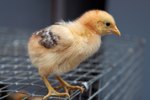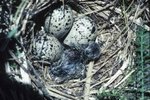
You can start your own flock with chicks, young hens called pullets or laying hens. Chickens come in different breeds and two sizes depending on the bird's purpose, so it pays to do your research ahead of time on the myriad options available.
Sizes
Folks in the chicken business call a standard-sized chicken "large fowl," while bantams are only one-third their size. Cochins have both sizes, but breeds called true bantams such as the Serama are bantam only. Bantam birds make suitable pets; large fowl may be pets or production -- egg or meat -- birds. If you're limited on space and don't mind smaller eggs, bantam hens may be the right choice. If you want birds that lay average-sized eggs or are looking for egg layers that produce nearly an egg a day, you'll want the large fowl size.
Egg Layers
Over the years, hatcheries bred production breeds such as Leghorns and production reds to maximize egg output. These birds are typically lighter and made for producing large quantities of eggs in the preferred colors of white or brown. The Leghorn breed produces large numbers of white eggs. Production red hens, also called a red sex-link, is a type of breed cross that lays the most brown eggs. Hatcheries give their versions names such as ISA Browns, cinnamon queens, red stars, production reds and gold sex-links. Black sex-links or black stars are another hybrid used for egg production.
Birds that lay blue or green eggs include Easter Eggers, Ameracaunas and Araucanas. Hens that lay chocolate-colored eggs include the Marans, Welsummers and Barnevelders.
Meat Birds
Meat hens or Cornish Crosses intended for the dinner table grow quickly and put on a lot of weight in a short amount of time. Consequently, they can suffer from heart attacks and other diseases. They lay infrequently and have short lifespans. Cornish crosses represent a mix between Cornish and Plymouth Rock breeds. Their parent breed, the Cornish, makes good meat birds without the fast growth or health problems.
Dual-Purpose Breeds
The dual-purpose breeds are possibly the best of both worlds. Dual-purpose birds quite often don't lay as much as the egg layers, but they lay more eggs than the meat birds. They're not as hefty as the meat birds, but are bigger and have more meat than those birds used strictly for egg laying. Their personalities can be anywhere from flighty to calm. Dual-purpose breeds include birds such as Orpingtons, Wyandottes, Chanteclers and the Plymouth Rocks.
Ornamental-type or Show Breeds
Chicken fanciers breed ornamental hens for their looks and personality rather than egg laying and meat potential. They can look very beautiful, or odd depending on your taste. Many have large crests or long feathers. Some, like the Silkies, are all down and fluff. Show birds include Polish, Sebright and Phoenix.
References
- Ithaca College Library: Henderson's Chicken Breed Chart
- Pocketful of Poultry; Carol Ekarius
- Raising Chickens for Dummies; Kimberly Willis and Rob Ludlow.
- BackYard Chickens.com: Breeds
- BackYard Chickens.com: Star
- BackYard Chickens.com: Cornish Cross
Photo Credits
-
Jupiterimages/BananaStock/Getty Images



